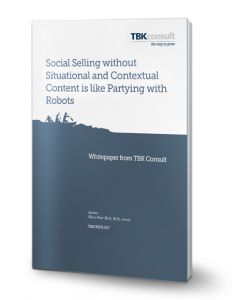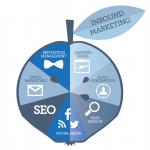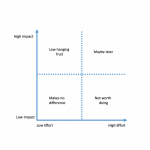Revenue Generation: Facilitating the Buyers’ Journey – Part 2
 Download this series of posts as an ebook.
Download this series of posts as an ebook.
Companies lie or at least they promise way more than they can deliver. Do you trust advertisements? Do you believe what companies say about themselves and their products/services?
I don’t, you don’t and your potential customers don’t.
In an era where the price of communication has dropped the volume of propaganda has increased correspondingly. Our customers are more careful than ever when they the venture to find solutions for their needs, challenges and opportunities.
At the same time our industry is constantly developing improvements and inventing completely new value propositions that our customers can benefit greatly from if they only knew about them.
This is your challenge. You have invested in something that has great value, but so have others and if you don’t grab a solid market share fast then your competitor will.
I hope this series of posts will give you inspiration on how you can improve your revenue generation process and achieve the market leadership position that I am sure you deserve.
Read Part 1
Read Part 3
Read Part 4
Read Part 5
The buyer’s journey
Put yourself in the shoes of your customers. How do we buy products and services?
The process illustrated above represents how a typical potential customer may go through a process of making a purchase. Please note that this process is unrelated to where in the buying process she actually is. Please also note that this process may take 15 minutes for buying something insignificant on the Internet or many years for buying a mission critical business process management system.
I know them
The potential customer can be in the final stage of making an investment decision or she can be totally unaware of an issue when she learns about you. We have just concluded that the vast majority of potential buyers are not in active buying mode, so we can also conclude that building awareness and making the first contact should not be based on messages (we may call all your messages “content”) that is focused on your products, your services and your company. Instead you should communicate something related to the issues (problems, challenges and opportunities) that the potential customers in your target market faces in her daily operation.
Let us re-emphasize this point:
Only a very small fraction of your potential buyers will at any point in time be looking for your type of products and services. Therefore, if you only communicate product and company information then you will make no impression on the vast majority of your potential customers. To catch the attention of the vast majority of your potential customers you must communicate content related to the issues they are facing.
Personas
 All significant business decisions involve more than a single person. An investment decision of a certain magnitude and importance may involve formulating a requirement specification, issuing a formal request for proposal to a handful of potential vendors, conducting several meetings with presentations and demonstrations, checking up on references, running proof of concept sessions, initiating pilot projects and then presenting the final recommendations to the committee running the procurement activity. Smaller purchases with less risk may be more informally processed, but will still need the consent of several stakeholders. Only insignificant commodities that are easily substituted may have a single decision maker.
All significant business decisions involve more than a single person. An investment decision of a certain magnitude and importance may involve formulating a requirement specification, issuing a formal request for proposal to a handful of potential vendors, conducting several meetings with presentations and demonstrations, checking up on references, running proof of concept sessions, initiating pilot projects and then presenting the final recommendations to the committee running the procurement activity. Smaller purchases with less risk may be more informally processed, but will still need the consent of several stakeholders. Only insignificant commodities that are easily substituted may have a single decision maker.
Let us re-emphasize this point:
All significant business decisions involve more than a single person.
The challenge in B2B revenue generation is that each of these stakeholders has a separate set of criteria on which they base their recommendations or decisions. The messages each of these personas need from you and the conversations that they may want with you are not the same.
Let’s take an example
You work for a company offering ERP[1] solutions. Who do you need to communicate with?
Today ERP solutions are an umbrella of solutions addressing various elements of how a company runs internal business processes as well as how they can communicate with suppliers and customers. Any ERP system is worthless until the operational processes that the system shall support are defined and the people that will use it are trained and motivated to do so.
Making a decision for acquiring an ERP system will involve a suite of interests from various parts of the customer’s organization. Who should you communicate with ensuring that companies will consider your solution, when they prepare to replace their ERP system?
 Let’s assume that your ERP software is targeted at companies that do engineering-to-order type solutions and that your solution besides support for the usual business processes can interface to the most common CAD[2] systems. Customers can use this interface in the CRM[3] module supporting proposal management, but the interface is also used in the [4]MRP module and in the customer services module. You have a shop floor control module allowing for both planning the production workflow, but also for keeping track of actual machine and resource utilization. You have an HR module that can be used for running salary management and payment, but also have facilities for allocating resources to projects and for HR development. You also offer a facility to do post calculation of orders and a cost controlling module allowing you to allocate fixed and variable costs according to your preferences.
Let’s assume that your ERP software is targeted at companies that do engineering-to-order type solutions and that your solution besides support for the usual business processes can interface to the most common CAD[2] systems. Customers can use this interface in the CRM[3] module supporting proposal management, but the interface is also used in the [4]MRP module and in the customer services module. You have a shop floor control module allowing for both planning the production workflow, but also for keeping track of actual machine and resource utilization. You have an HR module that can be used for running salary management and payment, but also have facilities for allocating resources to projects and for HR development. You also offer a facility to do post calculation of orders and a cost controlling module allowing you to allocate fixed and variable costs according to your preferences.
Your competitive edge is that you provide a fully integrated solution for engineering-to-order companies. There are certainly better “best of breed” solutions for CRM, HR management and other modules in the market, but integrating these with your system requires additional effort and customers have to reinvest every time each of these systems are upgraded.
A decision for including your software on the list of options that potential customers will consider and their final decision for choosing the vendor will involve many stakeholders. Who should you communicate with in the various stages of the buyer’s journey?
Most companies will pick 3-5 personas that they know are key for making a final decision. In the case above these could be:
 The CEO: With a fully integrated system and business intelligence tools you can probably provide the best overview. The CEO will appreciate a one vendor scenario and will prefer a vendor that is specialized in her type of business and can show off a long list of references. The CEO may consider you the low risk option. However, the CEO is not your key contact. It is highly unlikely that the CEO will push the decision for a certain vendor because this will leave a lot of responsibility on her table. The CEO doesn’t want a situation where the management team can say (on or off the record): “This was not my recommendation or decision.”
The CEO: With a fully integrated system and business intelligence tools you can probably provide the best overview. The CEO will appreciate a one vendor scenario and will prefer a vendor that is specialized in her type of business and can show off a long list of references. The CEO may consider you the low risk option. However, the CEO is not your key contact. It is highly unlikely that the CEO will push the decision for a certain vendor because this will leave a lot of responsibility on her table. The CEO doesn’t want a situation where the management team can say (on or off the record): “This was not my recommendation or decision.”
The CFO: The CFO is normally the focal point for the ERP system. She will appreciate the integration and especially the ability to do follow up on the actual performance of each order.
The CPO (Chief Production Officer): The CPO is the key decision maker in an engineering-to-order company. She is heavily involved with supporting the development of proposals for the sales people and she is the key person responsible for coordinating the delivery of the solution. If she fails the customer projects will be too late, too expensive and way off specs.
What about the marketing and sales managers, the HR manager, the engineering (design) managers, the customer services managers etc.? Unless you are a very, very big company you cannot afford to design and operate dedicated communication efforts with more than 3-5 personas. In the last mile (sales) of the customer acquisition process you will most likely have to deal with them all, but in the early stages of building relationships you should focus on a maximum of 3-5 personas.
Now let’s take a look at each step in the buyer’s journey.
To be continued
Notes:
[1] Enterprise Resource Planning
[2] Computer Aided Design
[3] Customer Relationship Management
[4] Material Requirements Planning
–ooOoo–
 You may also be interested in reading the whitepaper “Social Selling without Situational and Contextual Content is like Partying with Robots”
You may also be interested in reading the whitepaper “Social Selling without Situational and Contextual Content is like Partying with Robots”
The whitepaper defines the three types of content and explains how you decide when to provide your potential customers which each type. It then introduces the concept of marketing and sales as the facilitation of the buyer’s journey and explains that the nature of your business model determines to which degree you can take advantage of social media.
The whitepaper recommends how to build the basic foundation for using social media for sales purposes and concludes that it must be an integrated and managed part of your marketing mix and should not be left entirely to the individual sales person’s own initiative.








